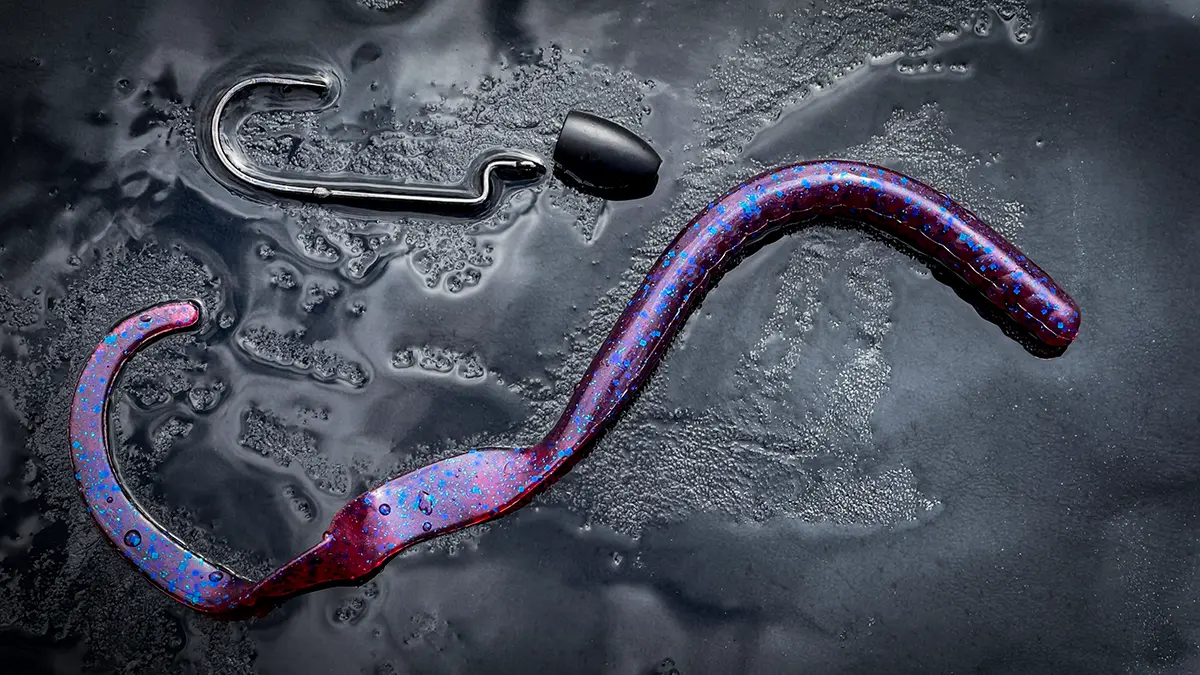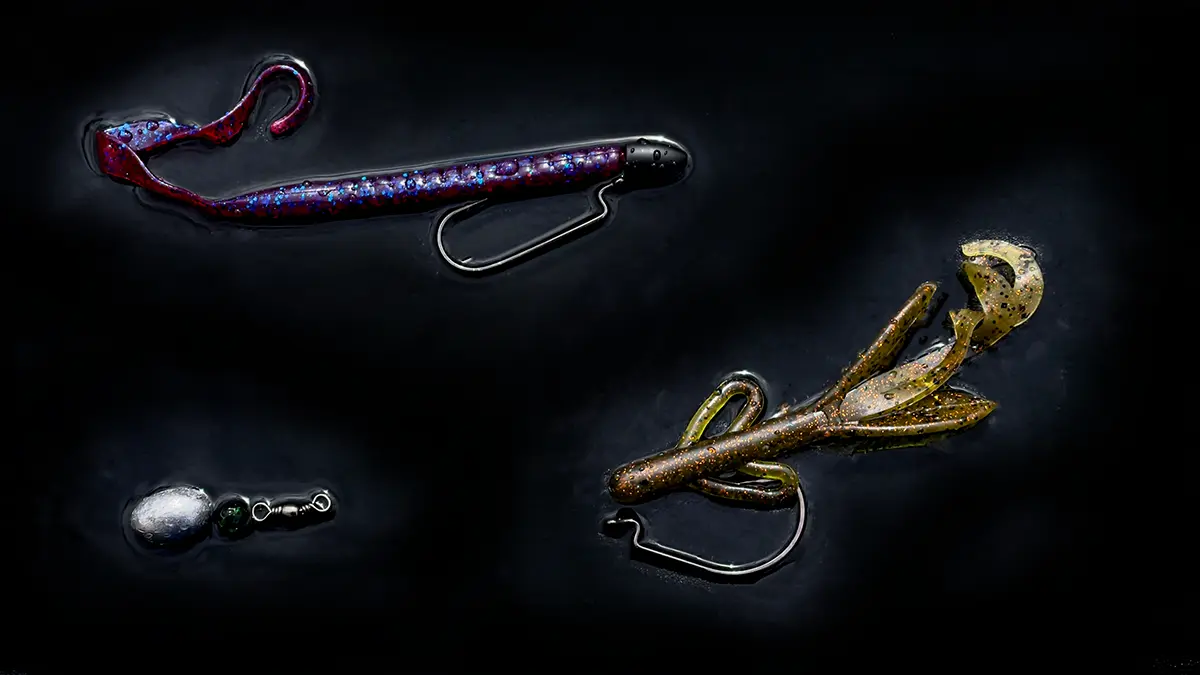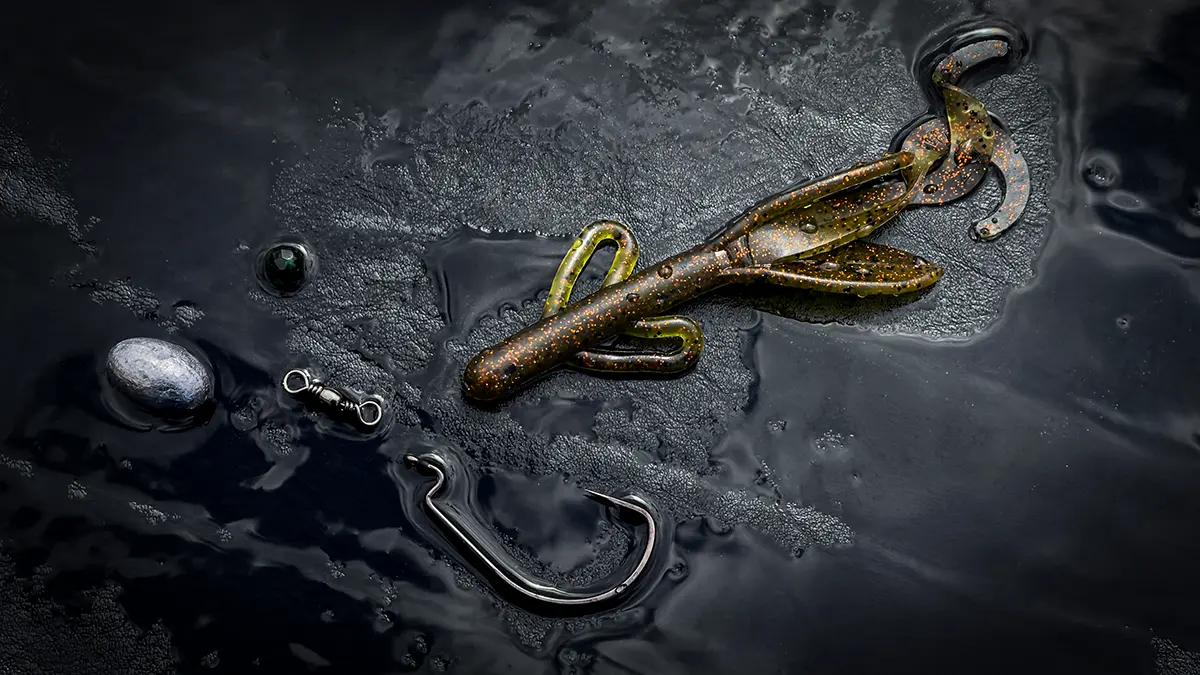Arguably the two most popular rigs for bass fishing soft plastics are the Texas Rig and the Carolina rig. But when an angler should use the Carolina Rig vs. the Texas Rig confuses some fishermen. So we’re going to give you a quick handy reference guide one when are the best times to throw a Texas rig versus a Carolina rig.
We’ve created lengthy guides to both the Texas rig and the Carolina rig where you can learn to tie, fish and most effectively use each rig, but this guide will give you a good recipe for when to use one versus the other.

What Texas Rigs Do Well
A Texas Rig is made to get your lure in and out of cover. Or to present a bait cleanly in an environment where snags are likely. And it can also function well just being drug along on the bottom. However where it shines really is in target fishing. Seeing a target and putting a bait in a precise spot on the target.
So if you’re flipping and pitching into holes in the grass or flooded willow bushes or under docks, then a Texas rig is a compact option that works a lot better than a Carolina rig. So I tell people a lot that a Texas rig is a lot of vertical presentations. You lift and drop the worm in and out of cover. You pitch to a target, let the worm get down in the cover and then you pull it out and pitch it to the next target. So it’s a lot of up and down.
A Texas rig also works with big worms and small beaver baits and creature baits alike. So you can go to a big ribbon tail worm like a Zoom Ol’ Monster when you’re fishing ledges out deeper and casting to the sweet spot on the ledge. And then you can rig a small beaver style bait like a Strike King Rodent on a Texas rig and pitch it directly into thick cover.
What Carolina Rigs Do Well
A Carolina rig is made more for covering water in a horizontal fashion. You make long casts, usually offshore or away from the bank, and you use your rod to sweep slowly and drag the rig along the bottom feeling for cover and likely fish holding spots until a fish bites. Usually it employs a little heavier weight with a leader that separates the lure from the weight.
Because of this setup, a Carolina rig is good at attracting fish in more open water areas like humps, flats, ditches, roadbeds, and long flat points. Anywhere where bass will group up away from the bank, a Carolina rig will find and catch them.
And the subtle action of a Carolina rig often makes it a fish drawing rig. As the weight scoots on the bottom, its kicking up silt, clicking and knocking. Then the lure is darting and ducking around freely behind it. As the weight hangs on little rocks and sticks and then frees, it causes the lure to dart around which makes it a very appealing horizontal presentation.
Carolina Rig vs Texas Rig by Season
There are some general guidelines to help you understand when one rig is better than the other. Starting in the prespawn, fish will congregate in areas that lead into to spawn areas. Places like points and flats the bass will stage and get ready to disperse shallow to start pairing up to spawn. While they are staging, a Carolina rig is a great tool for finding and catching schools of staging fish.
As the fish migrate into spawning areas, a Carolina rig works but a light Texas rig starts to take over as the better option, especially when the fish get on beds. Then it’s a lot of pitching and casting around to where you think or see fish bedding. Fishing around dock walkways, shallow grass, protected coves, high spots in a pocket or bay and around cover in the water are all places to fish a Texas rig in the spring.
As the fish finish up their spawn, some will stay around cover to guard their fry and a Texas rig is still very good here and weightless Texas rigs like floating worms become very good as well.
Then as the fish move offshore to start schooling up for the summer and feeding aggressively after the spawn, a Carolina rig comes back as a dominant player. Especially when the schools are on shallow places offshore before moving out deep.
As the bass get more offshore and further into the summer, the Carolina rig gives way to the Texas rig again as fish will start isolating on cover like brush piles, stumps and specific targets offshore.
Then as we move into the fall cover and vegetation become very dominant players and the Texas rig access although fish are a lot smarter and the ones schooling up in the backs of bays will fall for a subtle Carolina rig drug around.
As it moves into winter a lot anglers will continue to Carolina rig especially on lakes that have grass and are not terribly deep. It remains a player in the south until we get back into spring again where Texas rigs will take back over.
Fishing Applications for Carolina Rigs vs Texas Rigs
Like we said, pitching, punching, flipping and skipping into cover is best achieved with a Texas Rig. Dragging around away from the bank and specific targets and more on structure is where the Carolina rig really earns its keep in bass fishing. There are times where both can work well like in the summer when fish have been beat on offshore with a lot of power techniques.
A 7 to 10-inch worm on a Texas rig works equally as well as a 4-inch French fry on a Carolina rig. The worms on these two rigs seem to get a lot more bites than other presentations as we get into late summer time and schools that have been tuned up and educated by other anglers and other techniques.
Modifications for both fishing rigs
A few things you can change to make the rigs more effective in different scenarios. If the cover is sparse, a lighter weight will give your rig more action. The thicker it is the more weight you need. But a general rule with Texas rigs is to use the lightest weight you can feel to give the lures the most lifelike action.
You can also lighten up a Carolina rig and some folks go so light they use what’s called a split shot rig. So instead of leaders and swivels and sliding weights, they just pinch a split shot ahead of the lure a foot or three. These light rigs work well in shallow water and on suspending fish even at times. The baits will swim and dance more without being restricted by the weight.
You can add more beads between the weight and swivel on a Carolina rig for more noise. You can do the same on a Texas rig. If you use tungsten weights, you should use a tungsten or metallic bead as tungsten often breaks glass beads.
Texas rigs can be fished without a weight or you can drive a nail weight in the bottom of your worm under the hook and create a Reverse rig that pulls the bait down by the tail and you pull the worm up by the head. This can be very effective when fishing things like standing timber, tall brush piles, tall docks, etc.
So now you should have a good handle on when to fish a Carolina rig vs a Texas rig and you can choose the right rig for the right time of year and the right fishing situation to maximize your likelihood of catching fish.














